September 2, 2002
R rated - about a romantic novel, a mining town, and an extremely interesting museum
| Visiting a Brothel! September 2, 2002 R rated - about a romantic novel, a mining town, and an extremely interesting museum |
 |
||
| Today's Butte, MT, divides into old downtown (left), new subdivisions (right), and surface mines (back) |
A twist of fate brought us to Butte, Montana, but it did not take much to convince Sid that
this celebrity among towns would certainly offer something special. I had to admit, though, that my
knowledge of Butte almost exclusively comes from a cheap romance novel - Wanderers Eastwards,
Wanderers West by Kathleen Winsor.
But if you take the story and subtract some strikingly noble characters of several heroines, and their
too muscular, too romantic manly counterparts, we get a reasonably authentic account of first gold
prospectors, who did not find much gold, but did find a butte (a round hill) full off copper, silver and
other interesting metals. In 1870, the town registered population of 142 whites, one black, and 98 Chinese.
At the start of 20th century, thanks to rare metals, Butte grew almost overnight to seventy thousands,
bustling with nonstop business in mines and bars.
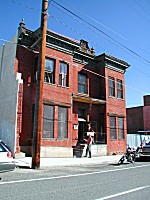 |
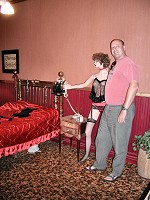 |
|||
| My husband should stop claiming that he does not visit brothels. As of today, I have got photographic proof! |
||||
A lady at our hotel's reception gave us a list of local attractions and I noticed that Butte offers more than we can possibly cover in a day. We quickly ruled out an ascent to a supersized white statue of Our Lady of the Rockies, we skipped a tour with a local guide, and selected two most interesting items: a mining museum with focus towards year 1880, and Dumas Brothel Museum. The brothel was on our way to the mining exhibit, so we stopped there first, despite it being historically younger by ten years.
Meeting Dumas Brothel's owner, Rudy Giecek, was an experience. His grandfather worked since age of ten in coal mines somewhere on Czech-Polish border; his father was involved in union movement in Pittsburgh, PA -- and Rudy chose his place in another mining town. Not as a miner; he's officially an antiques dealer, and runs his brothel without girls. He bought it from the last regular owner and manager of Dumas House, and began rescuing parts of a juicy history, which majority of the society tries to deny.
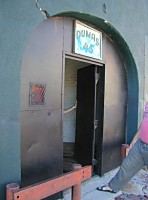 |
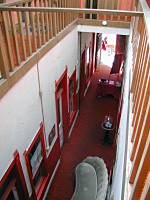 |
|||
| Proper back entrance | Corridor with shopping windows | |||
Dumas House was designed as a classical Victorian brothel, built in 1890, and served its purpose until 1982. It is said to be the longest continuously operating whorehouse in United States. How is that possible, when laws banning prostitution kept getting harsher, and only five years after opening, prostitution became a misdemeanor? Well... a misdemeanor could be fined by, say, ten dollars. The whole red district in Butte employed around one thousand ladies, who paid this fine to the city hall every month... using some simple math, once can quickly see how city budget could not easily do without such stable source of income. Later, when the issue was taken over by city police, a similar arrangement was found. Madam was fined, and officers allegedly enjoyed "toll-free services". Police used to call ahead of any raid, so that respectable citizens could evacuate through underground tunnels (Butte is a mining town, right?) back to their offices and clubs. Perhaps some less respectable citizen disappeared as well. Nevertheless, order and image was maintained.
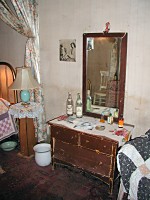 |
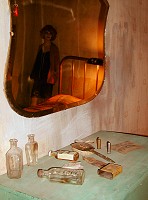 |
|||
| Well preserved equipment of formerly barred "cribs" | ||||
I was incredibly curious about this museum -- I have never been to a brothel before, and if any of my friends was, he had kept it for himself. Or maybe shared it with other chaps. Victorian concept of a whorehouse was a surprise for me. Right from the entrance, it had a long corridor with doors and big-pane windows on both sides -- a naughty shopping mall. Ladies stood in the windows, and gentlemen did some window shopping before they made a pick. Larger rooms were available on the 2nd floor -- apparently a workplace for those who did not need to work in "cribs" = bed-sized rooms. There were more cribs in the basement -- same system (windows to the hallway) like on first floor. When demand outpaced supply, the management added new cribs going directly into a back alley. The house had a total of 43 rooms, and in the times of greatest fame Dumas employed around hundred girls, who worked in shifts so that the business could run non-stop.
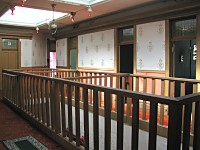 |
||
| High class rooms in 2nd floor |
In 1943 came an order to close all brothels - officially a part of war effort. Dumas barred its windows and doors, closing all rooms directly connected to the street, installed a new massive alley entrance, a bell and a peephole. The brothel continued to operate just as I always imagined such institution to do. A gentleman is discreetly led through an inconspicuous door into a salon, where he picks from present girls, and they leave into a boudoir. Large windows with "white meat" thus disappeared from the streets, but the show goes on.
War puritanism had an unforeseen side effect -- rooms that were barred in 1943 stayed empty and inaccessible -- until Rudy Giecek got to them. He collected all things that were left laying around. A pair of shoes, chewing gum wrappers, tubes with vaginal jelly, dilapidated clothes, cocaine packings, Havana cigar tips (they'd be contraband today), bottles that used to contain opium, beer bottles, perfumes, disinfectants, and an amazing form of lipstick. All metals were slanted for arms industry, and it was forbidden to waste them on "silly" stuff like rouge. So they started producing lipstick in the form of "matches" -- a little amount of rouge on a carton stick. Later they figured how to make carton cartridges similar to the original metallic ones. Rudy left original posters hanging on walls, including some indecent clips. He found erotic toys -- a small whip curled under one bed, or a four pound electric vibrator, with a plug that fits lightbulb socket -- the only one available in cribs. Surprising was a setting on a brothel timer found on one door -- it metered ten minutes -- only so much time had a customer to perform.
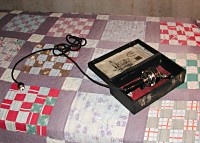 |
||
| A four pound electric vibrator |
With an expert explanation by Rudy, every detail adds to a careful history about this business. For example, a trodden lino in a crib -- a large spot near a window, where a lady presented her goods to potential customers; a path from a door to a stove, two spots there (details of a deal are being negotiated), next trodden spot at a washbasin, and finally bed -- legs dug deep through several layers of floor covers down to the original wood give us an idea, how heavily each part was used. The whole "workplace" is very efficient. It's exactly as wide as a standard bed is long -- which is located at the deep end, opposite to the window and door. A stove and a washbasin in between, maybe a small chair and a cabinet. Some rooms had trap doors or secret passages, besides the "regular" city underground access network. Sometimes it was necessary to hide a lady worker. One wanted French woman used a specially modified refrigerator -- from the outside, it had a door with a broken-off handle (to explain why it could not be opened) -- from the inside, it had a latch and some extra room just for one very skinny, crouching person.
Every really old house has to have its own ghost. Rudy's brothel is haunted, too -- in room No. 20. Elinore Knott, the brothel's madam in 1955, had an arrangement to leave with a man of high power, a man who she thought loved her. She packed a suitcase and waited for man who never came. Finally she realized she was waiting in vain, she went back to her room and out of despair poisoned herself with pills. She can be occasionally spotted, dragging her suitcase back upstairs.
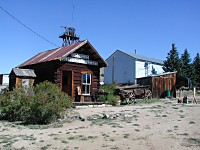 |
||
| Patterson's Sauerkraut Factory all fit in a little hut in foreground |
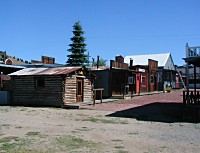 |
||
| Mining town museum in Butte |
Of course -- Butte does not consist exclusively of brothels. In an honorable museum at the outskirts of the old downtown, one can see preserved examples of all the other professions: an assayer, blacksmith, iceman, hatter, grocer, undertaker, confectioner, pharmacist, dentist, surgeon, union office, post office, bank, Chinese laundry, bar, upholstery. A cluster of buildings covers over fifty various businesses, mostly furnished with original inventory and equipment. It stroke me how dark and depressing all the interiors looked, including living quarters of a well-to-do family. Most objects and walls had dark, cold colors -- green, black, gray. That was the case in the brothel downtown, too. Well, either olive green was then all the rage, of our tastes had changed dramatically since hundred years ago. I consider the most curious exhibition being Peterson's Sauerkraut Factory. This "facility", dedicated to making kraut for the whole town, was doing great, and a hard-working couple originally from Belgium became quite famous. If you think about it -- Butte used to be far enough from any other civilization that it was not practical to import fresh fruit and other good things -- and so kraut got to be most likely a lonely variation on a humdrum winter diet.
We finally agreed that this was enough of cultural education (I admit without pressure that after Dumas, the mining museum did not get as much of my attention as it deserved). We found the only open restaurant on Labor Day (yes, even here, the celebration of work is done by everyone ceasing to work that day), and after having an uneventful lunch, we took off into our desired wilderness.
| Copyright © 2002-2005 by Carol & Sid Paral. All rights reserved. |